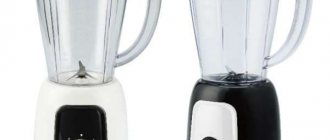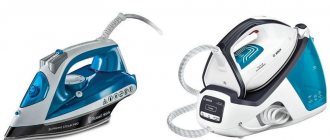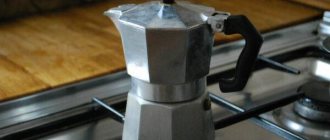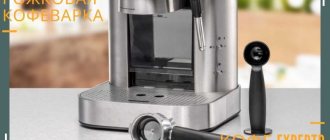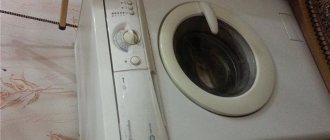Among the many kitchen aids are a mixer and a blender occupy honorable leading positions.
Both devices do an excellent job of mixing and whipping liquid ingredients, but each device has its own distinctive features and advantages.
To decide which unit is best to choose, it is worth learning more about the operating principle of each of them and comparing the technical characteristics of devices available on the market.
Page navigation:
Operating principle and features of mixers
For your information! The main working elements of the mixer are one or two metal whisks rotating at high speed, which ensure rapid mixing of bulk and liquid ingredients into a homogeneous mass.
As a result, the user receives an oxygenated mixture without lumps.
produced are divided into two types: manual and tabletop . The first option with a handle and a whisk attachment is designed for dipping into a bowl of food.
The stationary device, in turn, consists of a container mounted on a housing with control buttons.
Such a device completely frees the user’s hands, who only has to add the necessary components.
Functional purpose of devices
A mixer is a powerful device designed for mixing. It has various attachments and beaters. The equipment is needed for making cocktails, creams for cakes and something light. A blender is a more serious device that does not have whisks, but durable knives.
Stand mixers are significantly more expensive.
See also: Design principles for a small kitchen of 5 sq. m.
Operating principle and features of blenders
The grinding process using a blender is carried out due to the rotating movements of sharp knives made of high-strength stainless steel , forming a small cross.
Stay up to date! Thanks to the increased power while rotating at high speeds, the unit is able to grind both soft and hard products in just a few seconds.
The stores offer stationary and hand-held immersion blenders .
Stationary models are a body with a control panel and a bowl mounted on top for loading ingredients.
The manual design includes an ergonomic handle with buttons and a tall glass for food.
What is better to buy
We figured out the functions and the device, but the answer to the question – what to choose – has not yet been found.
So, in order to buy the right equipment, you need to create tasks that need to be solved with their help. To make your choice easier, I offer a short list listing the types of equipment and their functions.
- Hand mixer or stationary mixer with blender attachment and chopper - whipping light and dense substances, grinding non-solid substances, mixing cocktails, preparing purees and baby formula.
- Hand blender - mixing any products, grinding hard and soft products (ice, chocolate, nuts, herbs, fruits, etc.), whipping low-density mixtures.
- Stationary blender - preparing smoothies, cocktails, various kinds of purees, any mixtures.
From the list above it is clear that the functions overlap in many ways, but when purchasing, I advise you to choose the type of equipment that is designed for the task, and cannot perform it with the help of additional attachments, namely, a blender is bought to grind and mix, and a mixer to beat The fact is that even with the presence of additional functions, an unsuitable device may perform poorly. A home mixer has a power of about 0.5 kW, that is, even with an attachment, it will not make the mixture as well as a blender whose minimum power should start from 700 W.
If, due to certain conditions, it is impossible to buy both types of equipment and you need to choose which option is better, then you should evaluate the pros and cons. A blender will not make dough, and a mixer will not grind solid foods. Which function is more important will become fundamental when choosing.
Advantages and disadvantages of devices
Manual and stationary mixer models are famous for such advantages as:
- quick and convenient whipping of liquid ingredients;
- the ability to create airy mousses and lush mixtures;
- ergonomics, mobility and light weight;
- no need for special maintenance;
- acceptable price.
Among the disadvantages of the mixer are the inability to grind solid products and slight heating of the body during operation.
Unlike a mixer, a blender has advanced functionality and a more modern design.
Keep in mind! The device has other advantages, including:
- versatility of use;
- availability of additional attachments;
- ability to grind hard products;
- high productivity and efficiency;
- convenient control panel.
the disadvantages of advanced blenders :
- higher cost;
- dimensions of the structure;
- work with a higher level of sound.
When do you need a blender?
It has more functions, it is usually more powerful, but it also takes up more space and is more difficult to clean. Functionality is determined by a set of attachments:
- main nozzle with two rotating knives for chopping food in any container;
- whisk for whipping liquid products;
- container with built-in knives (grinding, mixing);
- attachments for shredding, dicing or slicing.
All of these attachments are supplied with submersible instruments only. Tabletop models simply mix products and are usually used to make smoothies, cocktails, and other drinks from fresh berries, fruits or vegetables.
This kitchen assistant quickly mixes, chops, chops and whips. When beating products, a blender can be used as a mixer, but it is important to choose the right operating speed. If it is too high, the consistency of the dough or cream may not be correct (the products will be mixed to a homogeneous mixture without air). Therefore, when comparing which is better, a blender whisk or a mixer, for those who often prepare dough and puffed creams, it is better to choose the second option.
There is one more difference in what a mixer does and what a blender does: kneading stiff dough. Blenders do not have hooks that can be used to do this, and they are not designed for slow rotation of the attachments. For those who bake frequently, replacing a mixer with a blender will not work.
Comparisons and differences
The table shows the difference between a mixer and a blender.
| Operation to be performed | Blender | Mixer |
| Batter | + | + |
| Dough with the consistency of thick sour cream | + | + |
| Pie dough | — | + |
| Beating egg whites | — | + |
| Preparing mayonnaise | — | + |
| Grinding nuts and crackers | + | — |
| Ice crushing | + | — |
Which model is better to choose?
A few tips from experts in the field of household appliances will help you solve the dilemma and decide on the choice of device:
- if there are small children in the family, it is better to use a blender - the device will help you instantly prepare pureed vegetables or fruits with the ideal consistency;
- fans of sports nutrition will also find a blender useful - they can make a protein drink or smoothie in a matter of seconds;
- A blender will also be an indispensable assistant for housewives who often prepare homemade baked goods - preparing dough and creams will definitely not take much time;
- to create a homogeneous or porous structure, you will need a compact mixer - a simple and easy-to-use device that can instantly cope with light tasks;
- if the unit is purchased for infrequent use, a mixer with 2-3 speeds and several attachments included will be a good solution.
Which is better to choose: a blender or a mixer?
With an electrical kitchen appliance, you can quickly prepare your favorite dish, especially if the model is powerful. First, the housewife must figure out what operations she performs most often while preparing food. Advice from experienced consumers will help you choose a kitchen appliance:
- To prepare homemade pastries or desserts, it is better to buy a mixer. He will quickly knead the dough, whip the airy cream, and mix a delicious cocktail.
- If you have a baby in the house, you will need a blender to prepare the first complementary foods. With its help you can get delicious vegetable or fruit puree.
- Using a blender with advanced functionality, you can easily prepare puree soup and chop a variety of products.
Advice! It is better to buy a device designed to perform a specific task, since additional attachments do not always give the desired result.
TOP 3 best mixers
#1
Kitfort KT-1343
A universal device with many programs and functions that simplify the work.
A powerful stationary mixer with a planetary mixing system that fully complies with high quality standards.
During operation, the installed nozzle rotates around its axis and quickly moves in a circle, thoroughly mixing the loaded products.
A high-power engine and a sufficient number of attachments allow you to obtain a mixture with an ideal consistency.
Specifications:
- power – 1000 W;
- number of speeds – 6;
- number of nozzles – 3;
- case material – plastic;
- weight – 4.5 kg.
Advantages
- quality of materials and workmanship;
- elegant and stylish design;
- almost silent operation;
- intuitive interface;
- the presence of an easily removable protective cover.
Flaws
- the whisk does not reach the edges of the bowl while beating;
- slight odor from the protective plastic cover;
- short time of continuous operation.
#2
Bosch MFQ 3010
A highly reliable device that combines multifunctionality, high-quality assembly and an affordable price.
An ergonomic two-speed model with four attachments included, which is powerful enough to complete any task.
An important feature of the electric unit is the high quality of materials - thanks to this, the device is reliably protected from mechanical damage.
The mixer also has a pulse mode for quickly mixing ingredients.
Specifications:
- power – 300 W;
- number of speeds – 2;
- number of nozzles – 4;
- case material – plastic;
- weight – 0.9 kg.
Advantages
- easy removal and replacement of attachments;
- accelerated operation in pulse mode;
- reduced sound power level;
- compact design and light weight;
- high strength materials.
Flaws
- slight heating of the plastic case;
- there is a slight vibration during whipping;
- the appearance of a specific odor when operating at high speeds.
#3
Philips HR3745/00 Viva Collection
An attractive multi-tasking mixer that stands out for its quiet and long-lasting operation.
A planetary mixer, presented in a durable snow-white plastic case and complemented by suction feet, necessary for a stable positioning of the device on the work surface.
The design is equipped with a capacious bowl designed for 3 liters of liquid, a cone-shaped whisk for whipping and hooks for kneading dough.
Specifications:
- power – 450 W;
- number of speeds – 5;
- number of nozzles – 4;
- case material – plastic;
- weight – 4 kg.
Advantages
- work in accelerated turbo mode;
- wide selection of work programs;
- button for convenient detachment of attachments;
- attractive appearance;
- device for winding electrical cable.
Flaws
- no mixing spatula included;
- noisy operation at maximum power;
- plastic bowl for ingredients.
Arguments for separate appliances
Reasons why people do not want to use a two-in-one device:
- Haute cuisine requires perfection in everything, including kitchen appliances. And if you prepare complex dishes, the option with a blender will be simpler for you.
- Even a good blender with a high-quality whisk will not be able to beat, for example, thick dough, which a good mixer with special attachments can do.
- A device with low power and an unreliable whisk with thin rods cannot be compared with a mixer: it will mix, but it will take longer and worse to beat. Similar reviews can be found about the Kenwood device, but before purchasing you need to evaluate more carefully how good this or that model is.
- In the case of a blender, there is another problem: when whipping cocktails and other liquids, they splash out of the container. This doesn't happen with a mixer.
TOP 3 best blenders
#1
Philips HR2621/90 Viva Collection
High-performance equipment that will help diversify the menu by taking direct part in the process of preparing interesting dishes.
A sophisticated submersible model with continuously adjustable speed and an ultra-ergonomic rubberized handle that is comfortable to hold in your hand.
To prevent splashing, the manufacturer has equipped the universal gadget with a unique wave-shaped protective nozzle.
In addition to the main device, the delivery package includes an oversized chopper. The structural elements can be cleaned in the dishwasher.
Specifications:
- power – 800 W;
- number of speeds – 1;
- number of nozzles – 3;
- case material – plastic, metal;
- weight – 1.3 kg.
Advantages
- reliable protection against overheating;
- long warranty period;
- quick change of accessories with one button;
- easy power control;
- rich equipment.
Flaws
- The cord may not be long enough;
- presence of plastic odor;
- vibration during operation.
#2
Kitfort KT-1344
An ergonomic device with a detailed design that can cope with tasks of any complexity.
An inexpensive but productive model that effectively combines the functions of two devices: a chopper and a stationary blender.
The unit is equipped with a pulse mode and three operating speeds.
Thanks to this, the user will be able to create the perfect dish without any effort.
The desired mode is selected using the regulator located on the body.
Specifications:
- power – 800 W;
- number of speeds – 3;
- number of nozzles – 4;
- case material – plastic, metal;
- weight – 4.5 kg.
Advantages
- smooth speed control;
- simple mechanical control;
- optimal number of operating speeds;
- the presence of a spacious glass jug;
- high-quality grinding of solid products.
Flaws
- plastic smell;
- the appearance of scratches on the body;
- high noise level.
#3
Bosch MSM 66130
An electric unit that lovers of delicious homemade food cannot do without.
A device with a comfortable handle and a metal immersion part, 12 operating speeds and smooth speed control.
Comfortable and, most importantly, safe operation is guaranteed by the presence of a long electrical cable and protection against splashing of components.
Removable parts can be cleaned either by hand or in the dishwasher.
Specifications:
- power – 600 W;
- number of speeds – 12;
- number of nozzles – 2;
- case material – plastic;
- weight – 1.7 kg.
Advantages
- ice crushing function;
- reliable attachment of nozzles;
- measuring cup with lid;
- a large number of speeds;
- laconic design.
Flaws
- no chopper included;
- increased noise and vibration levels;
- heating of the case during prolonged operation.
conclusions
When choosing between a mixer and a blender, it is important to remember the following nuances:
- a hand mixer is suitable for simple tasks , but a stationary one will help you prepare a large number of different dishes;
- for cooking solid foods, it is better to choose a blender - it is much more functional, but its cost is slightly higher;
- the main technical parameters of the devices are power consumption and the number of operating speeds ;
- special attention must be paid to the safety system, quality of materials and workmanship, as well as the number of replaceable nozzles;
- For convenient use, you should give preference to a model with a long power cord.
